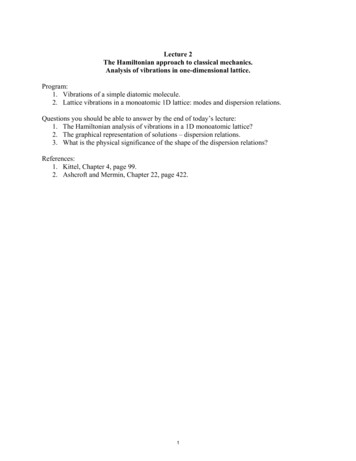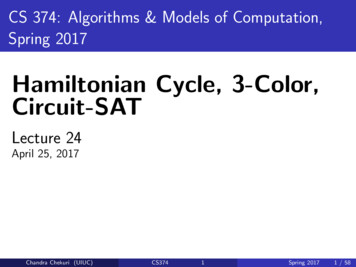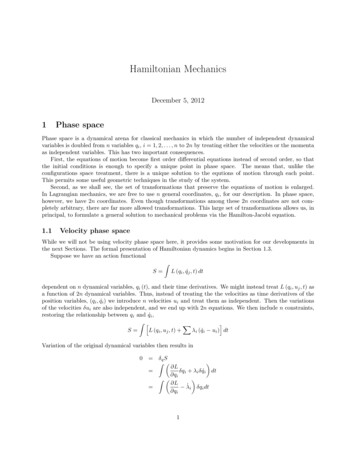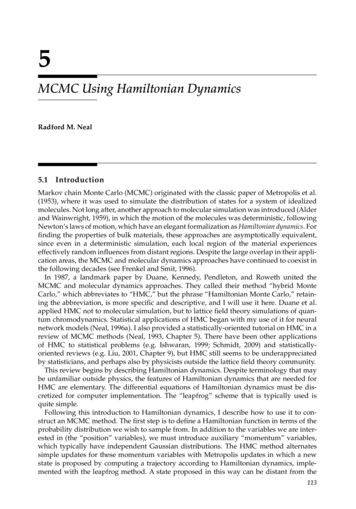
Transcription
Lecture 2The Hamiltonian approach to classical mechanics.Analysis of vibrations in one-dimensional lattice.Program:1. Vibrations of a simple diatomic molecule.2. Lattice vibrations in a monoatomic 1D lattice: modes and dispersion relations.Questions you should be able to answer by the end of today’s lecture:1. The Hamiltonian analysis of vibrations in a 1D monoatomic lattice?2. The graphical representation of solutions – dispersion relations.3. What is the physical significance of the shape of the dispersion relations?References:1. Kittel, Chapter 4, page 99.2. Ashcroft and Mermin, Chapter 22, page 422.1
Example III: 1D Diatomic moleculeHere we will consider a simple diatomic molecule – let’s say H2, where two hydrogen atoms arebound to each other with a single sigma bond. Since the bond is stretchable and compressible toa certain extent we can approximate it with a spring, and approximate the hydrogen atoms asballs attached to its ends. We will soon learn that this model doesn’t work to explain electronicstructure but for our purposes of understanding lattice vibration it provides a sufficientframework.I. The system: Two atoms (approximated) by balls of mass m are bound by a stretchable bondapproximated with a spring of length l and stiffness K. Here the position and momentum of theleft atom are x1 and p1, the position and momentum of the right atom are x2, p2.mml, KII. The Hamiltonian.The energy for this molecule is: E mv12 mv22 l 2 p12 p22 K2 K x2 x1 l 222 2m 2m 2Then the Hamiltonian for this system is:H x1 , p1 ; x2 , p2 p12 p22 K2 x2 x1 l 2m 2m 2III. The Hamilton’s equations of motion for this system are: H H H H x , p , x , p ;t p dx1dt dx1 p1 m p1 dt m x1 , p1 , x2 , p2 ;t dpdpdx2 p2 1 K x2 x1 l 1 x1dtdt dtm x1 , p1 , x2 , p2 ;t dp1p dx 2 2 dt K x2 x1 l p2mdt dp2 K x x lx1 , p1 , x2 , p2 ;tdp2dp221 dt K x2 x1 l x2dtdt11221 The Hamilton’s equations yield the following equations of motion:2
d 2 x1,2K x2 x1 l 2mdtThese coupled first order equations can be solved by generating uncoupled second orderequations (See Mathematica Notebook posted for this lecture). u x x x1 u z l / 212 2 z x2 x1 ld x2 u z l / 2 x1 x2 0 2 2 dtd u 2du 02u t u 0 t2K d dtx x x x ldt t 021 dt 2 2 1 d 2 z 2Km z 0z t Aei 2 K m t Be i 2 K m t2m dtIf we take initial conditions to be, then we find solutions:Example IV: Longitudinal vibrations of a one 1D monoatomic lattice.(Can also be applied to cubic crystals with a mono-atomic basis.)I. The systemConsists of ions located on a lattice defined by a lattice vector sa. The ions are assumed to bedeviating from their respective lattice points by a distance us, which is taken to be smaller thanthe lattice constant a.usas-1ss 1II. The HamiltonianWe assume that the elastic energy is quadratic in the displacement, then we can write the totalenergy of the lattice is:mv 21p2K22E lattice s K xs 1 xs a s us 1 us 22sss 2ms 2Then it is convenient to write a Hamiltonian for the crystal as a function of displacement usrather than coordinate xs:3
H sps2 1 K u u2m 2 s s 1 s 2III. Hamilton’s equations of motionThrough the application of Hamilton’s equations we derive the equations of motion:dp H sdt us H dus psdtFocus on the terms in the Hamiltonian that contain us and ps22ps2 11Hs K us 1 us K us us 1 . 22m 2We then obtain:dus ps dt mdps K us 1 us K us us 1 K us 1 us 1 2us dtd 2us Ku u 2us 2m s 1 s 1And the equations of motion are in the form: dt Look for solutions that have a time dependence of the form e i t , and substitute back in theabove equation to obtain a difference equation:d 2 us i tus e 2 2usdtK 2us u u 2usm s 1 s 1 i s 1 kaThis difference equation has solution of the form: us uo eiksa , then us 1 ue where a is thelattice constant and k is called the wavevector (wavenumber as a scalar). iksa i tThen the total displacement of an ion s at time t can be written as: uk s,t uoeSubstituting us into the difference equation above, we find: 2 e iska K i s 1 ka i s 1 kaK ika ikae e 2e iska 2 e e 2mm 2 k 4Kka2K1 cos ka k sinMM2 4
Dispersion relationsThe last equation defines the dispersionrelation k , which is a periodic function1of k.The dispersion relation constitutes agraphical representation of the independentsolutions. If we know the boundaryconditions, i.e. a vector of initial0.8w0.60.4 displacements u1 0 ,.us 0 ,. and initial0.2 du dus1 ,.,. ,velocitiesdt t 0 dt t 0k and ω define a solution.0-3-2-10k123Physical characteristics of the solutions:1. Crystal cannot transmit sound at frequencies above:4K max M2. The ratio of two adjacent displacements is:us 1 ueik s 1 a eika , which indicates that a solution involving k and a solution that hasusueiksaa k’ k n2π/a are equivalent. 3. Unique solutions only for those values of k that are restricted to the first BZ: k aad 4. Phase velocity: c and group velocity: vg dkk Ka 2kacosM21.0υg(Ca2/M)1/20.50π02aπaKImage by MIT OpenCourseWare.5. Standing waves at the edge of the Brillouin zone for solutions where k satisfies: k .aAdjacent atoms move in opposite directions the wave is not propagating (group velocity isvg 0).5
This is the same condition that is satisfied when you get the so called Braggreflections in optics (or x-ray diffraction). Recall the condition for Bragg diffraction:k is the wavevector and is related to the wavelength by:We just saw from the analysis above that we get standing waves atwhich is identical to the Bragg condition.6. Long wavelength limit occurs when ka 1. Under these conditions, the wavelength ismuch larger than the lattice spacing, chain can be treated as a continuum. The dispersionrelations may be expanded in a Taylor series near ka 0:2K 2 k 1 cos ka M ka cos ka 1 2 and the velocity of sound vg 2 O ka 4 KkaMd K a is independent of frequency, similar to thedkMcontinuum model.6
MIT OpenCourseWarehttp://ocw.mit.edu3.024 Electronic, Optical and Magnetic Properties of MaterialsSpring 2013For information about citing these materials or our Terms of Use, visit: http://ocw.mit.edu/terms.
The Hamiltonian approach to classical mechanics. Analysis of vibrations in one-dimensional lattice. Program: 1. Vibrations of a simple diatomic molecule. 2. Lattice vibrations in a monoatomic 1D lattice: modes and dispersion relations. Questions you should be able to answer by the end of today's lecture: 1.










